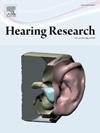性腺源性类固醇激素介导C57BL/6J小鼠青春期至成年早期耳蜗听觉编码成熟的性别差异。
IF 2.5
2区 医学
Q1 AUDIOLOGY & SPEECH-LANGUAGE PATHOLOGY
引用次数: 0
摘要
以前有报道称,性成熟的雌性哺乳动物的外周听觉敏感性增加,通常表现为与雄性相比,听觉脑干反应(ABR)波I振幅更高。在这里,我们通过记录雌性和雄性野生型(WT)以及四个核心基因型(FCG) C57BL/6J小鼠的abr,确定了潜在的激素和遗传(即XX-与xy相关的基因)对这种性别差异的贡献。出生后第38天(P38)和第65天(P65)的WT雌性小鼠以及卵巢处于P65的FCG小鼠的波I振幅高于雄性,而性腺去骨小鼠的波I振幅则不存在差异。此外,在WT小鼠中,我们研究了从青春期前(P25)到青春期后青春期晚期到成年早期(P38, P65和P95)耳蜗和耳蜗核中波幅的性别差异的开始和持续时间。在雌性和雄性小鼠中,波I振幅从P25到P95下降了50%。然而,在P38和P65处,雌性的振幅分别比雄性高22%和11%。在去腺细胞的小鼠中,由于雌性去腺细胞的减少,在任何年龄的测试中,波I振幅都没有性别差异。相比之下,我们发现在假手术和去性腺的雌性和雄性WT小鼠中,波II振幅在这些年龄保持相对恒定。综上所述,数据表明性腺来源的激素在青春期晚期和成年早期之间不同程度地细化了波I的成熟程度,而不是波II的成熟程度。本文章由计算机程序翻译,如有差异,请以英文原文为准。
Gonad-derived steroid hormones mediate a sex difference in the maturation of auditory encoding in the cochlea from adolescence to early adulthood in C57BL/6J mice
Sexually mature females of multiple mammalian species were previously reported to have increased peripheral auditory sensitivity, often measured as higher auditory brainstem response (ABR) wave I amplitude compared to males. Here, we determined potential hormonal and genetic (i.e., XX- vs. XY-linked genes) contributions to this sex difference by recording ABRs in gonadally intact and gonadectomized female and male wildtype (WT) and four core genotypes (FCG) C57BL/6J mice. WT females at postnatal day 38 (P38) and P65, and FCG mice with ovaries at P65 had higher wave I amplitude than males, and the difference was absent in gonadectomized mice. Furthermore, in WT mice, we addressed the initiation and duration of the sex difference in wave amplitude from pre-pubescence (P25) through maturation from post-pubescent late adolescence to early adulthood (P38, P65, and P95) in both the cochlea and cochlear nucleus. In both female and male mice, wave I amplitude decreased by 50 % from P25 to P95. However, the amplitude in females was 22 % and 11 % higher than males at P38 and P65, respectively. In gonadectomized mice, there was no sex difference in wave I amplitude at any age tested, due to a decrease in gonadectomized females. In contrast, we found that wave II amplitude remains relatively constant over these ages in both sham and gonadectomized WT female and male mice. Together, the data suggest that gonad-derived hormones differentially refine the maturation of wave I, but not wave II, amplitude between late adolescence and early adulthood.
求助全文
通过发布文献求助,成功后即可免费获取论文全文。
去求助
来源期刊

Hearing Research
医学-耳鼻喉科学
CiteScore
5.30
自引率
14.30%
发文量
163
审稿时长
75 days
期刊介绍:
The aim of the journal is to provide a forum for papers concerned with basic peripheral and central auditory mechanisms. Emphasis is on experimental and clinical studies, but theoretical and methodological papers will also be considered. The journal publishes original research papers, review and mini- review articles, rapid communications, method/protocol and perspective articles.
Papers submitted should deal with auditory anatomy, physiology, psychophysics, imaging, modeling and behavioural studies in animals and humans, as well as hearing aids and cochlear implants. Papers dealing with the vestibular system are also considered for publication. Papers on comparative aspects of hearing and on effects of drugs and environmental contaminants on hearing function will also be considered. Clinical papers will be accepted when they contribute to the understanding of normal and pathological hearing functions.
 求助内容:
求助内容: 应助结果提醒方式:
应助结果提醒方式:


